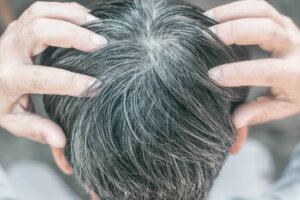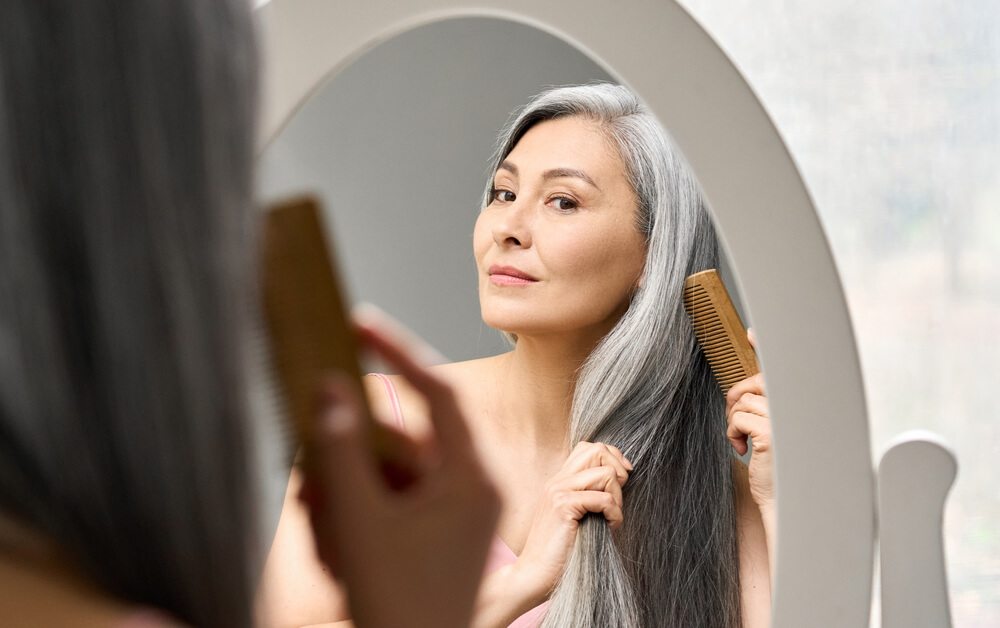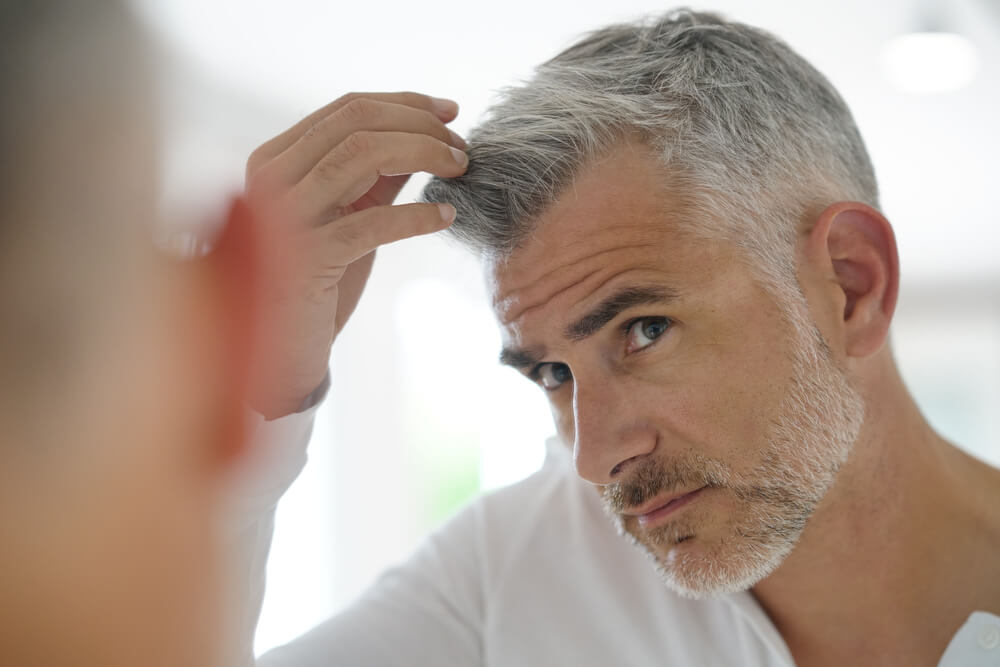This Is How Hair Ages

Hair has a leading role in physical appearance and people’s self-perception. Together with the skin, it undergoes the main visible changes in relation to age. Hair ages in many ways, with different results in both men and women. These changes manifest themselves naturally, although certain habits and factors can cause them to be more premature or pronounced.
For example, experts warn that intense UV exposure has multiple implications for hair aging. Loss of color, shine, brittleness, rigidity, dryness, and rough surface texture are some of the sequelae. Today we won’t focus on these, but, rather, on the changes that naturally occur in the hair as a result of the passage of time.
3 ways that hair ages
Everyone knows that aging leads to a number of changes in the hair. Not everyone experiences the same changes, as these can vary according to each person. These differences aside, here are 3 ways that hair ages.
1. Changes in its texture and thickness

The thick, coarse hair of a young adult eventually gives way to thin, fine hair with age. As experts point out, these changes also cause changes in its texture when handling it. Some authors call this senescent alopecia; that is, the natural thinning of the hair due to natural aging.
2. A reduction in hair density
Perhaps one of the most significant changes that occur in the hair as a consequence of aging is the reduction of its density. As researchers point out, there are significant differences between the density of the hair of a 20-year-old and a 60-year-old. The change occurs in both men and women, although for different reasons it’s more pronounced in men.
It’s known as male pattern hair loss and female pattern hair loss, but is popularly referred to as alopecia or baldness. It’s estimated that up to 50% of men will experience some degree of male pattern hair loss. This is a progressive change, and one that can begin before the age of 30.
3. Changes in its color

Another of the changes in hair due to aging most evident to the naked eye is color. According to experts, by the age of 50, 50% of a person’s hair will show signs of graying. In men, it usually starts on the sideburns and temples, while in women, gray hair develops around the perimeter of the hairline.
The speed with which hair changes color depends on genetics. The original color also influences, and it can take on different shades of gray and white.
Hair graying occurs regardless of gender and its actual color, and in some contexts it can appear before the age of 2 years. People with fair complexions usually show this change first than people with darker complexions.
Can hair aging be stopped?
Hair aging is a natural process. There’s nothing you can do to prevent it from appearing, although some habits can cause it to appear prematurely or be more intense. We have mentioned how exposure to radiation from the sun is one such habit. We highlight others from the experts :
- Constant exposure to humid environments and wind.
- The use of chemical products on the hair (such as dyes).
- The use of hot tools on the hair (irons, dryers and others).
- The frequency and intensity with which it is combed.
- The way the hair is pulled tight when wearing caps, hats, or certain hairstyles (such as ponytails and braids).
- Harmful habits like smoking.
- General hygiene habits.
- Diet.
All these factors affect how hair ages, and by carrying out the above activities people can accelerate the appearance of gray or white hair. Unlike other types of changes due to age, this one doesn’t have any type of consequence on physical health. On the other hand, it does have it from a psychological point of view.
Certainly, anxiety and insecurity are common reactions to such changes. Sometimes these can even lead to acute episodes of stress and depression. Some measures can be taken in this regard, and you can consult a dermatology professional. However, remember that most changes are irreversible and you have to learn to deal with them.
Hair has a leading role in physical appearance and people’s self-perception. Together with the skin, it undergoes the main visible changes in relation to age. Hair ages in many ways, with different results in both men and women. These changes manifest themselves naturally, although certain habits and factors can cause them to be more premature or pronounced.
For example, experts warn that intense UV exposure has multiple implications for hair aging. Loss of color, shine, brittleness, rigidity, dryness, and rough surface texture are some of the sequelae. Today we won’t focus on these, but, rather, on the changes that naturally occur in the hair as a result of the passage of time.
3 ways that hair ages
Everyone knows that aging leads to a number of changes in the hair. Not everyone experiences the same changes, as these can vary according to each person. These differences aside, here are 3 ways that hair ages.
1. Changes in its texture and thickness

The thick, coarse hair of a young adult eventually gives way to thin, fine hair with age. As experts point out, these changes also cause changes in its texture when handling it. Some authors call this senescent alopecia; that is, the natural thinning of the hair due to natural aging.
2. A reduction in hair density
Perhaps one of the most significant changes that occur in the hair as a consequence of aging is the reduction of its density. As researchers point out, there are significant differences between the density of the hair of a 20-year-old and a 60-year-old. The change occurs in both men and women, although for different reasons it’s more pronounced in men.
It’s known as male pattern hair loss and female pattern hair loss, but is popularly referred to as alopecia or baldness. It’s estimated that up to 50% of men will experience some degree of male pattern hair loss. This is a progressive change, and one that can begin before the age of 30.
3. Changes in its color

Another of the changes in hair due to aging most evident to the naked eye is color. According to experts, by the age of 50, 50% of a person’s hair will show signs of graying. In men, it usually starts on the sideburns and temples, while in women, gray hair develops around the perimeter of the hairline.
The speed with which hair changes color depends on genetics. The original color also influences, and it can take on different shades of gray and white.
Hair graying occurs regardless of gender and its actual color, and in some contexts it can appear before the age of 2 years. People with fair complexions usually show this change first than people with darker complexions.
Can hair aging be stopped?
Hair aging is a natural process. There’s nothing you can do to prevent it from appearing, although some habits can cause it to appear prematurely or be more intense. We have mentioned how exposure to radiation from the sun is one such habit. We highlight others from the experts :
- Constant exposure to humid environments and wind.
- The use of chemical products on the hair (such as dyes).
- The use of hot tools on the hair (irons, dryers and others).
- The frequency and intensity with which it is combed.
- The way the hair is pulled tight when wearing caps, hats, or certain hairstyles (such as ponytails and braids).
- Harmful habits like smoking.
- General hygiene habits.
- Diet.
All these factors affect how hair ages, and by carrying out the above activities people can accelerate the appearance of gray or white hair. Unlike other types of changes due to age, this one doesn’t have any type of consequence on physical health. On the other hand, it does have it from a psychological point of view.
Certainly, anxiety and insecurity are common reactions to such changes. Sometimes these can even lead to acute episodes of stress and depression. Some measures can be taken in this regard, and you can consult a dermatology professional. However, remember that most changes are irreversible and you have to learn to deal with them.
- Cranwell, W., & Sinclair, R. Male androgenetic alopecia. 2015.
- Lee WS. Photoaggravation of hair aging. Int J Trichology. 2009 Jul;1(2):94-9.
- Leerunyakul K, Suchonwanit P. Evaluation of Hair Density and Hair Diameter in the Adult Thai Population Using Quantitative Trichoscopic Analysis. Biomed Res Int. 2020 Feb 10;2020:2476890.
- Trüeb RM, Rezende HD, Dias MFRG. A Comment on the Science of Hair Aging. Int J Trichology. 2018 Nov-Dec;10(6):245-254.
- Trüeb RM. Pharmacologic interventions in aging hair. Clin Interv Aging. 2006;1(2):121-9.
- Whiting, D. A. Comparative histopathology of androgenetic alopecia, diffuse alopecia, and senescent alopecia. In Aging Hair. 2010; 61-65.
Este texto se ofrece únicamente con propósitos informativos y no reemplaza la consulta con un profesional. Ante dudas, consulta a tu especialista.







